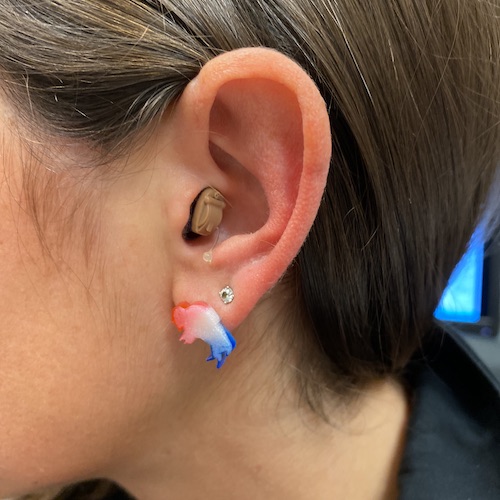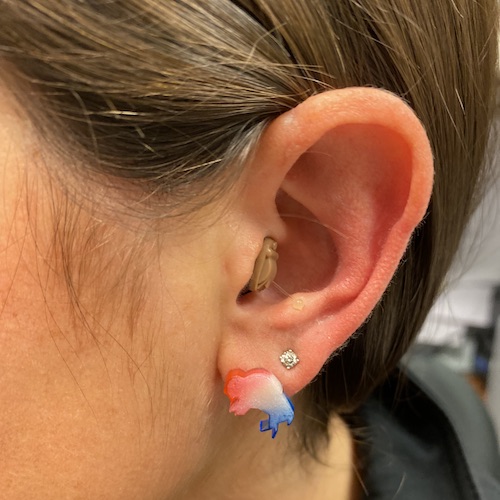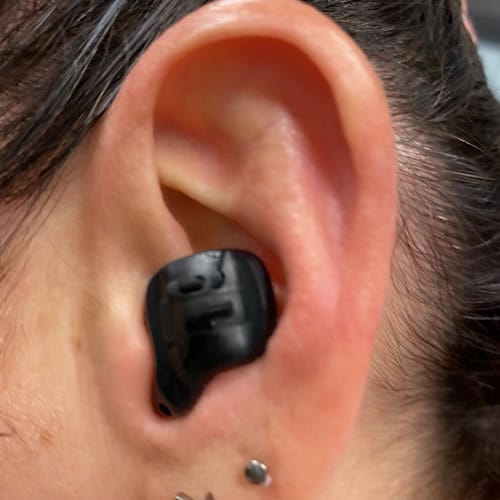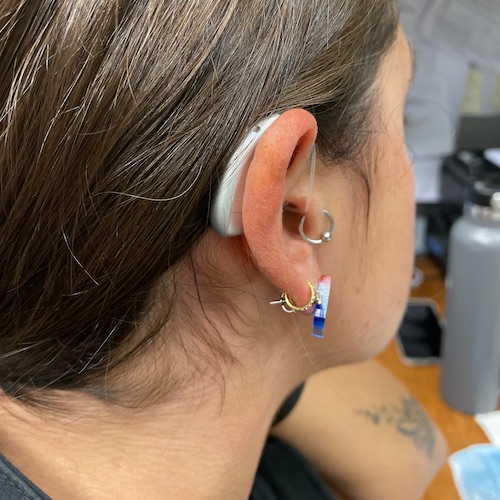Types of Hearing Aids
Today’s digital hearing aids are typically offered in various technology levels, such as Basic, Entry, Advanced, or Premium. Basic aids generally require the wearer to make some manual adjustments in certain listening environments, such as turning the volume control up or down, or pushing a button to change a listening program. In contrast, a Premium, or more advanced, hearing aid responds automatically to changes in the listener’s environment, making changes based on the signals being detected by the hearing aid. As the level of technology increases in the hearing aid, so does the availability of advanced features.
When selecting a hearing aid, the following is considered:
- The degree of hearing loss
- Manual dexterity and visual abilities of the patient
- Patient budget
- Skin sensitivities and anatomical considerations
- Lifestyle and listening needs

Styles of Hearing Aids:
In-the-Ear (ITE)
Hearing aids worn in the ear are usually custom-fit, based on a cast or impression of the ear. They're available in different skin tones to camouflage with the outer ear. There are several styles – each is listed below, ranging from smallest to largest.

Invisible in canal (IIC)
The smallest custom style, IIC instruments, sit invisibly in or past the second bend of the ear canal. IIC devices are specifically designed for mild-to-moderate hearing loss.

Completely in canal (CIC)
One of the smallest custom styles, CIC instruments, fit deeply and entirely within the ear canal. They fit mild-to-moderate hearing losses and offer high cosmetic appeal, as they're nearly invisible when worn.

In the canal (ITC)
ITC instruments sit in the lower portion of the outer ear bowl, making them comfortable and easy to use. Because they're slightly larger than CIC models, they have a longer battery life, and can host additional features such as directional microphones for better understanding in noisy environments, and controls such as volume controls. They fit mild and moderate hearing losses.

Full shell in the ear (ITE)
Full shell models sit flush within the entire ear bowl. Their size allows the maximum number of additional controls and features such as directional microphones, which require space on the outer portion of the instrument. They use a larger battery size than the smaller styles and can fit a larger receiver with enough power for even some severe hearing losses. Because of their flexibility, they're widely recommended for mild-to-severe hearing loss.

Half shell in the ear (ITE)
Half shell models are designed to fit inside half of your ear bowl and is made to fit the shape of your ear. They are relatively discreet, have a longer battery life than smaller styles, and can have additional features.
Behind-the-Ear (BTE)
Models sit behind or on top of the outer ear, with tubing that routes sound down into the ear. An ear tip or earmold is worn in the ear canal to secure the tube. With several models to choose from, BTE’s come in a variety of colors to either blend with your natural hair or skin tones or showcase your personal style.

Behind the ear (BTE)
Models sit behind or on top of the outer ear, with a thin wire that routes sound down into the ear. An ear tip or earmold is worn in the ear canal to secure the tube. With several models to choose from, BTE’s come in a variety of colors to either blend with your natural hair or skin tones or showcase your personal style.

Receiver in Ear (RIC)
RIC models are mini BTEs that have the speaker of the instrument incorporated in the ear tip, instead of in the main body of the instrument. RIC instruments fit mild-to-severe hearing losses. This hearing aid style looks similar to the Mini BTE when worn on the ear.
School and Clinic Locations
Let Us Help
At Buffalo Hearing & Speech Center, we are dedicated to helping you overcome any hearing, speech, communication, or educational need you have. Call us to speak with a Specialist or Write Us A Message.
The solution starts here!




